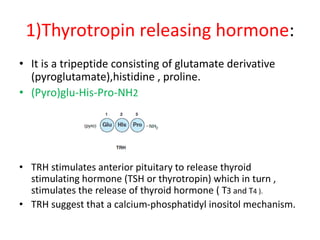This document summarizes pituitary and hypothalamic hormones. It describes how the hypothalamus regulates the anterior pituitary through releasing factors. The anterior pituitary then regulates other endocrine glands through six main hormones: growth hormone, thyroid stimulating hormone, adrenocorticotropic hormone, follicle stimulating hormone, luteinizing hormone, and prolactin. The posterior pituitary secretes oxytocin and antidiuretic hormone. Each hormone's structure, function, and role in feedback loops controlling hormone release is summarized.










































